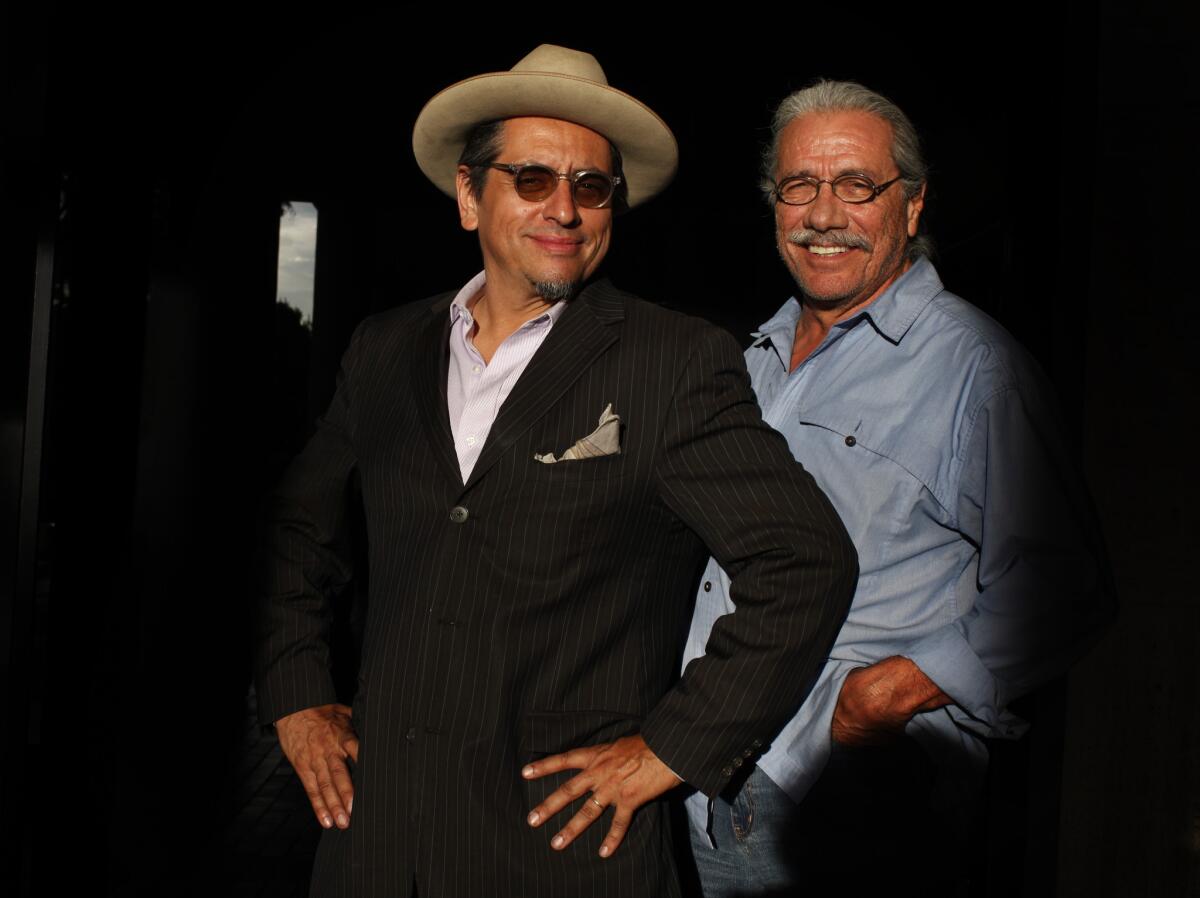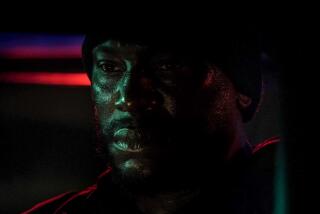‘Water & Power’ stakes out its turf

The stated goal for the gritty, neo-noir drama “Water & Power” isn’t simply to take a deep narrative dive into what one character in the new movie terms the “contrails of corruption” in modern Los Angeles.
According to its writer-director Richard Montoya, the $600,000 indie — which hit 21 theaters across Southern California in limited release on Friday — intends to accomplish for L.A.’s Chicano population what such films as “The Godfather” or “Casino” respectively did for Italian immigrants in New York and Jewish American empire builders in Las Vegas.
That is, capture a coming-of-age moment when an ethnic community goes from being a minority concern in its host city to an entrenched force for systemic criminality in its own right.
“In L.A., it isn’t just about the Anglo-Saxon power structure of the ‘40s and ‘50s — the big, bad white guys from Pasadena to Bel Air — anymore,” Montoya explained. “Hispanic ambition can lead to Hispanic corruption in present-day L.A. We are now joining the elite ranks of the bad guys.”
An adaptation of Montoya’s acclaimed stage production of the same name that won a Los Angeles Drama Critics Circle Award and an Ovation Award for best new play after debuting to sellout crowds at the Mark Taper Forum in 2006, “Water & Power” also represents a coming-of-age moment for its creator.
With financial backing from Arizona businessman Jim Flach, the movie was shot at breakneck pace in 2012. But filming at “Water & Power’s” primary motel location was briefly shut down on its first day of production thanks to a nearby double-homicide investigation.
“By hook or by crook, we got it done in 12 furious nights on the streets of L.A.: South Central, Boyle Heights, downtown,” Montoya said. “Because I didn’t know better, I thought 12 nights was an eternity and $600,000 was a fortune. The budget for the play at the Mark Taper was higher.”
The movie is an outgrowth of Montoya’s work as a founding member of the Latino comedy-theater ensemble Culture Clash, the first time the troupe’s work has been adapted for film. Along the way, “Water & Power’s” seven-year journey from stage to screen involved a period of creative incubation at the Sundance Institute Screenwriters and Directors Labs and a grant from the Annenberg Foundation en route to premiering at the L.A. Latino Film Festival in 2012.
There the film found its most ardent champion in Edward James Olmos, who helped Montoya broker a distribution deal with AMC Theaters. Now, “Water & Power” makes its way to the multiplex with a “presented by” credit from the crusading Mexican American actor-director-producer who has tirelessly championed Latino representation across television and movies for the better part of four decades.
In the afterglow of Antonio Villaraigosa’s historic election as L.A.’s first Mexican American mayor in over a century, Montoya was inspired to write “Water & Power” after a succession of high-visibility scandals across the Southland involving Latino clergymen, elected officials’ and police officers’ arrests and indictments. The movie, like the play, follows a pair of Angeleno brothers nicknamed Water and Power by their father, a DWP worker who instills in them world-beating values and an unshakable sense of Eastside pride in between swigs of vodka.
Gilbert, a.k.a. Water (played in the film by “Without a Trace” star Enrique Murciano) transcends his hardscrabble origins to become a state senator pushing a green-space initiative that will plant a million trees stretching from East L.A. to South Central. His brother, Gabriel (a.k.a. Power, portrayed by Nicholas Gonzalez), becomes an LAPD beat cop who wrestles with “the thug life of the boys and girls in blue,” which is presented as a necessary consequence of his position.
When Gabriel murders a gang-connected ex-con in the film’s opening act, his unexplained actions upset a roiling cauldron of race relations, greed and big-city corruption that stretches the brothers’ sibling loyalty to the breaking point.
For his part, Olmos places “Water & Power” within an Angeleno-set Latino movie continuum that includes several films for which the actor-director is best known: 1981’s “Zoot Suit” (which unfolds during the Mexican American pachuco riots of 1940s L.A.), the Eastside-set high school drama “Stand and Deliver” and 1992’s “American Me” (following members of the Mexican mafia in the California prison system).
“In the progression of those films, you start to understand Los Angeles,” Olmos noted. “Not from the perspective of the Westside looking eastward. But from the Eastside looking out upon itself and to the west.”
Befitting its setting, “Water & Power” is peppered with references to local touchstones — Tommy Trojan, Shoreline Crips, Jamba Juice, Silver Lake hipsters — as well as glancing mentions of such local eminences as activist Tom Hayden and L.A. County Supervisor Gloria Molina. It even features a cameo from City Councilman Gil Cedillo, whose blue-collar Boyle Heights upbringing inspired the brothers’ back story in the film.
Although AMC is known primarily as one of the nation’s largest theater operators, the company has a sideline in independent film distribution. And earlier this year, as part of its limited “Water & Power” roll-out, AMC began showing the movie’s trailer before showings of “Captain America: The Winter Soldier” and “Cesar Chavez,” the biopic about the Mexican American labor leader that has fared poorly at the box office since its release last month.
Noting that film’s lackluster financial performance, and that “Water & Power” faces stiff competition over its opening weekend in theaters, up against “The Amazing Spider-Man 2,” Montoya seemed to relish “Water & Power’s” position as scrappy underdog.
“We’ve got buses of people coming from Fresno this weekend, people making sure ‘Water & Power’ can live to next weekend,” the director said. “We’ve got skateboard crews fliering East L.A. We’re putting fliers on the side of taco trucks. We know where our people go.
“We’re up against Spider-Man. But we’ve got spider web tattoos on our arms,” he said. “We’ve got the audacity!”
More to Read
Only good movies
Get the Indie Focus newsletter, Mark Olsen's weekly guide to the world of cinema.
You may occasionally receive promotional content from the Los Angeles Times.











